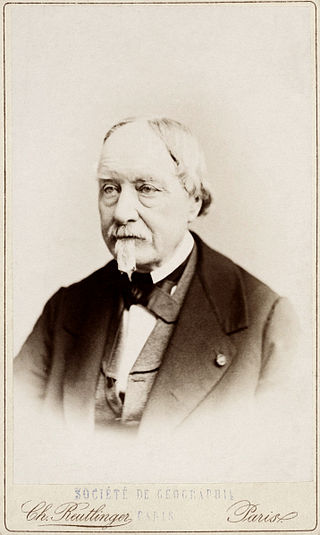Related Research Articles
Alfred Charles Auguste Foucher (1865–1952), was a French scholar, who argued that the Buddha image has Greek origins. He has been called the "father of Gandhara studies", and is a much-cited scholar on ancient Buddhism in northwest Indian subcontinent and the Hindu Kush region.

Paul Eugène Pelliot was a French Sinologist and Orientalist best known for his explorations of Central Asia and his discovery of many important Chinese texts such as the Dunhuang manuscripts.

Sylvain Lévi was an influential French orientalist and indologist who taught Sanskrit and Indian religion at the École pratique des hautes études.

William McGuckin, known as Baron de Slane was an Irish orientalist. He became a French national on 31 December 1838. and held the post of the Principal Interpreter of Arabic of the French Army from 1 September 1846 until his retirement on 28 March 1872. He is known for publishing and translating a number of important medieval Arabic texts.

Gérard Fussman was a French indologist who was a professor at the Collège de France.
Rolf Alfred Stein was a German-born French Sinologist and Tibetologist. He contributed in particular to the study of the Epic of King Gesar, on which he wrote two books, and the use of Chinese sources in Tibetan history. He was the first scholar to correctly identify the Minyag of Tibetan sources with the Xixia of Chinese sources.

Jacques Bacot was an explorer and pioneering French Tibetologist. He travelled extensively in India, western China, and the Tibetan border regions. He worked at the École pratique des hautes études. Bacot was the first western scholar to study the Tibetan grammatical tradition, and along with F. W. Thomas (1867–1956) belonged to the first generation of scholars to study the Old Tibetan Dunhuang manuscripts. Bacot made frequent use of Tibetan informants. He acquired aid from Gendün Chöphel in studying Dunhuang manuscripts.

Jean Paul Louis François Édouard Leuge-Dulaurier was a French Orientalist, Armenian studies scholar and Egyptologist.
Louis Bazin was a French orientalist.
Jacques Gernet was an eminent French sinologist of the second half of the 20th century. His best-known work is The Chinese Civilization, a 900-page summary of Chinese history and civilization which has been translated into many languages.
Henri Auguste Omont was a French librarian, philologist, and historian.

The Old Tibetan Chronicle is a collection of narrative accounts and songs relating to Tibet's Yarlung dynasty and the Tibetan Empire. The three manuscripts that comprise the only extant copies of the Chronicle are among the Dunhuang Manuscripts found in the early 20th century in the so-called "hidden library" at the Mogao Grottoes near Dunhuang, which is believed to have been sealed in the 11th century CE. The Chronicle, together with the Old Tibetan Annals comprise Tibet's earliest extant history.

Françoise Robin is a Tibetan-studies professor at Paris' National Institute of Oriental Languages and Civilizations (INALCO), where she specialises in the language, cinema, and literature of Tibet. Robin is currently the general secretary of the International Association for Tibetan Studies.

Barthélemy Mercier de Saint-Léger was a French abbot and librarian.
Michel Soymié was a French scholar and author working in the field of Chinese popular religion and literature. As a professor at the École Pratique des Hautes Études (EPHE) in Paris he directed a research group working on the Dunhuang manuscripts collected in China by the Paul Pelliot expedition of 1906-1908 which eventually evolved into the Centre de recherche Civilisation chinoise. He was responsible for publishing the collaborative catalogue of the Pelliot Dunhuang manuscripts.
Madeleine Laurain-Portemer was a 20th-century French historian, specializing in the history of Mazarin and his time, married to Jean Portemer (1911-1998).
Charles Samaran was a 20th-century French historian and archivist, who was born in Cravencères and died at Nogaro, shortly before his 103rd birthday.
Henri Pognon was a French archaeologist, epigrapher, and specialist in Assyriology.
François Déroche is an academic and specialist in Codicology and Palaeography. He is a professor at the Collège de France, where he is holding "History of the Quran Text and Transmission" Chair.
Jean-Pierre Drège is a French sinologist, specialising in the study of ancient books and the history of libraries, in particular Chinese manuscripts and Dunhuangology. He has been working for years in the study of the Dunhuang manuscripts.
References
François Pouillon (2012). Dictionnaire des orientalistes de langue française. KARTHALA Editions. p. 586. ISBN 978-2-8111-0790-1.